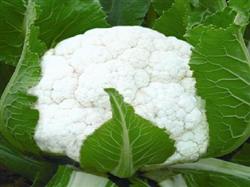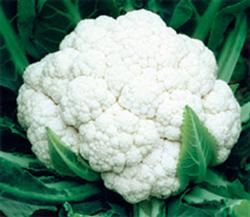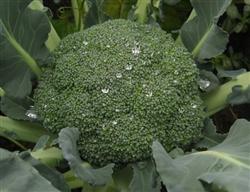Pollution-free cultivation techniques of precocious cauliflower

Cauliflower has the characteristics of palatability and delicious taste. Siyang County has mastered the pollution-free cultivation technology of early-maturing cauliflower through two years of cultivation. Variety selection according to the local climate characteristics, you can choose Li Yuanfu, Shenliang generation, Shenlong extra large and other varieties with a growth period of 50-60 days. The suitable time for sowing and open-field cultivation is generally from late June to early July, and the harvest time is from late August to early September. 500 kg of clean garden soil and 100 kg of rotten organic fertilizer per mu are used to prepare nutritious soil, requiring a humidity of 75%. Hands do not drip water, landing from a height of 1 meter will disperse. The seedbed should be far away from pollution, and the water, soil and atmosphere should meet the requirements of pollution-free cultivation, high and cool terrain, good ventilation and convenient drainage and irrigation. Land preparation to make a border, 1.1 meters wide, 20 centimeters high, flat and fine. Fill the nutrition bowl with 8 cm in length, width and height with 8-9 soil, and arrange it one by one on the border soil, with 1 seed in each bowl, with a sowing depth of 0.5 cm, covered with fine soil, sprayed with water, and covered with a sunshade net behind a small arch shed. The seedling stage should be managed to sprinkle water in time according to the weather conditions after sowing, and keep the seedling bed moist before emergence, with the bed not whitening as the degree. After emergence, chlorothalonil was sprayed every 5 days to prevent diseases in the seedling stage. Pay attention to the uncovering management of the sunshade net in the seedling stage, and cover the sunny day from 09:30 to 04:30 Cover with plastic film when it rains to improve the seedling rate and strong seedling rate. 10 days before transplanting, 5 kg urea per mu of seedling bed was applied and seedlings were refined. Every index of transplanting field should meet the requirements of pollution-free production. Ploughing and tanning in time 10 days before transplanting. Spread 50-75 kg of fresh lime per mu, leaving narrow ditches in the field with a depth of 80-100 cm. A week before transplanting, 2500 kg of rotten organic fertilizer, 20 kg of urea, 50 kg of superphosphate and 10 kg of potassium chloride were applied per mu of field. The seedling age is 20-25 days. When the seedling has 4-5 true leaves, the double-row "product" shape transplanting, the row spacing is 60 cm, the plant spacing is 35-40 cm, transplanting 2500-2800 plants per mu. Before field management and planting, 2 kg of urea and 1 kg of boron fertilizer per mu were poured with chemical water, and after planting, combined with fixed root water, it was applied again. Five days after planting, 5-8 kg of urea per mu was applied between the two cauliflower plants, and then every 7 days, the amount of fertilizer was increased by 1 kg, while 2 kg of superphosphate and 1 kg of potassium chloride were applied. After budding, among the four cauliflower plants, 10 kg of urea, 30 kg of superphosphate and 7.5 kg of potassium chloride were applied per mu, and 50 grams of potassium dihydrogen phosphate and 20 kg of water were sprayed per mu. The roots and buds were cultivated once respectively. After the flower ball has eggs, fold the leaves and cover the ball in time to prevent the flower ball color from turning yellow. After the emergence of diseases, pests and weeds, spray chlorothalonil with 50 grams of water per mu of seedling bed every 5 days. Field black root disease can be irrigated with 1000 times solution, black rot, soft rot, 150,200g of agricultural streptomycin per mu plus water spray. In order to control insect pests, insect control net was used to cover cultivation. Weeds in the seedbed are pulled out manually, and weeds in the field stage can be sprayed with 40% butachlor 125 ml per mu plus 60 kg of water in the evening of the same day. Timely harvest bouquet fully grow, the edge of the outermost twigs and bouquets are harvested when there are cracks.
- Prev

Integrated control of diseases and insect pests in balsam pear
The waterlogging tolerance of cauliflower is poor. When planting cauliflower in rainy areas and under the environment of high groundwater level, the technical measures of deep trench and high chamber should be taken to facilitate drainage, which is the key to the success of cauliflower cultivation. Cauliflower also avoid continuous cropping, the previous crop to melons, eggplant fruits, legumes and vegetables are appropriate, should choose fertile.
- Next

Planting techniques of precocious cauliflower
First, varieties with a growth period of more than 220 days should be selected and seeds should be mixed with new high-fat membrane. Second, the seedling bed must be shaded and moisturized. During the seedling period, insects should be treated every 7 days. Spraying new high-fat film at the seedling stage can prevent bacterial infection, improve the ability to resist natural disasters, improve the intensity of photosynthesis, and protect the seedlings from growing.
Related
- Where is it suitable to grow horseradish in China? it is expected to see the middle altitude horseradish in Alishan.
- How to prevent tomato virus disease reasonably? (Control methods included)
- Many people like to plant towel gourd on the balcony. What are the main points of this method and management?
- What crops can chili peppers be mixed with?
- Fertilization techniques and matters needing attention in Tomato
- What are the grafting techniques for peach seedlings in spring?
- Harm and control methods of root swelling disease of Chinese cabbage
- What are the pests of sweet potatoes? How to prevent and cure it?
- Symptoms, causes and Control methods of navel Rot in Tomato
- The cause of "Cucumber rotten bibcock" in Farmers' planting Cucumber and its Control Plan

